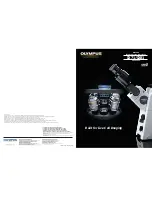
OPERATION
Axio Scope.A1
Illumination and Contrasting Method
Carl Zeiss
M60-2-0007 e 05/08
93
4.1.12
Adjusting Reflected Light Fluorescence
(1) General principle of operation
The reflected light fluorescence method is used to show fluorescent substances in typical fluorescence
colors in high contrast. The light originating from a high-performance illuminator in a reflected light
fluorescence microscope passes through a heat protection filter onto an excitation filter (bandpass). The
filtered short-wave excitation radiation is reflected by a dichroitic beam splitter and is focused on the
sample through the objective. The sample absorbs the short-wave radiation before emitting longer-wave
fluorescence radiation (Stokes’ Law). This radiation is then captured from the image side by the objective
and passes through the dichroitic beam separator. Last, the beams pass through a band-elimination filter
(longpass/bandpass) and only the long-wave radiation emitted by the sample passes.
The spectra of the excitation and the band-elimination filters must match very closely. They must be
inserted in a reflector module FL P&C together with the according dichroitic beam splitter.
(2) Instrumentation
−
Appropriate objectives, e.g. EC Plan-Neofluar or Fluar (UV-excitation)
−
Reflector module FL P&C and safety shutter in the upper part (additional shutter function with the
filter slider is optional)
−
Lamp HBO 100 or HBO 50, Colibri or HXP 120 for reflected light illumination for reflected
illumination
−
Fluorescence protection shield
The mercury vapor short arc lamp must be adjusted before starting the reflected light
fluorescence method. Re-adjusting the adjustment might become necessary depending on the
length of operating time.
(3) Adjusting reflected light fluorescence
Adjusting the reflected light fluorescence is facilitated when starting with a objective of average degree
of magnification, e.g. EC Plan-Neofluar 20x/0.50, and a sample of high fluorescence. The use of
demonstration samples is also advisable for the start-up.
If necessary, remove the compensator
λ
, which was used for the transmitted light polarization
method, from its compartment before adjusting the reflected light fluorescence.
•
Slide the fluorescence protection shield in the compensator compartment above the nosepiece.
•
Switch on the objective EC Plan-Neofluar 20x/0.50.
•
Turn the condenser turret to the position H transmitted light/bright-field first (or choose phase
contrast if using a Ph objective) and go to the sample detail to be examined.
•
Keep the light path in the reflected light illuminator blocked via the elimination position of the filter
slider reflected light (
690H690H
Fig. 4-16/
2
).
Summary of Contents for Axio Scope.A1
Page 1: ...Operating Manual Axio Scope A1 Microscope for Routine and Entry Level Research...
Page 23: ...TECHNICAL MANUAL Axio Scope A1 Systems Overview Carl Zeiss M60 2 0007 e 05 08 23...
Page 24: ...TECHNICAL MANUAL Carl Zeiss Systems Overview Axio Scope A1 24 M60 2 0007 e 05 08...
Page 25: ...TECHNICAL MANUAL Axio Scope A1 Systems Overview Carl Zeiss M60 2 0007 e 05 08 25...
Page 26: ...TECHNICAL MANUAL Carl Zeiss Systems Overview Axio Scope A1 26 M60 2 0007 e 05 08...
Page 122: ......
Page 123: ...Click below to find more Mipaper at www lcis com tw Mipaper at www lcis com tw...
















































